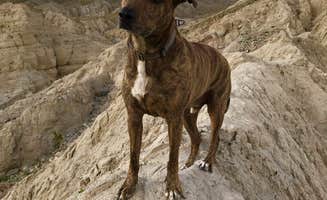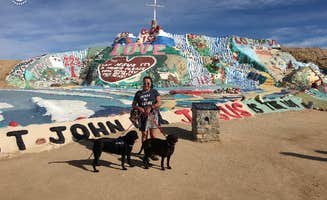Ocotillo Wells camping sits within the Colorado Desert region of California at approximately 425 feet elevation. The area experiences extreme seasonal temperature fluctuations with summer highs regularly exceeding 110°F and winter temperatures dropping into the 30s at night. Dispersed camping areas feature a mix of hard-packed and soft sandy terrain across the 85,000-acre vehicular recreation area, requiring campers to prepare for desert conditions year-round.
What to do
Explore historic trails: Near Blair Valley Primitive Campground, visitors can hike to native petroglyphs. "Ochre petroglyphs, fantastic night sky views, a variety of flora and fauna, hiking, and some challenging 4x4 lines await you here," notes Jeremy A. The area contains historical evidence of Kumeyaay settlements with metates and morteros visible in rock formations.
Stargaze during clear nights: The region offers exceptional dark sky viewing opportunities. "We witnessed some of the most gorgeous sunrises and sunsets here. Being a dark sky community, we were able to see so many stars and constellations. We saw shooting stars nearly every minute," reports E. from Blair Valley. Some campers recommend bringing small telescopes for optimal night sky observation.
Take advantage of natural hot springs: Visit Agua Caliente County Park Campground for geothermal pools. "2 outdoor pools and an indoor adult spa (102 degrees)... This place is well maintained and the cleanest campground I have ever stayed at," writes Alan T. The natural mineral springs feed three separate pools, including an adults-only option maintained at higher temperatures.
What campers like
Distance from crowds: Finding isolation is possible even during busy periods. "Plenty of open space to get away from the crowds. Plenty of open space to get away from the crowds," notes Timothy A. about Ocotillo Wells State Vehicular Recreation Area. The expansive terrain allows campers to create significant space between sites.
Minimal light pollution: Dark skies create prime conditions for astronomy enthusiasts. One camper at Culp Valley noted: "The stars are amazing so don't be afraid to sleep outside! It gets a little windy but nothing too crazy. The best part is that it's FREE!" The elevation changes throughout the region provide various vantage points for stargazing.
Geological features: The surrounding landscape offers unique formations and terrain. At Fish Creek Wash Primitive Campsite, "The grounds sit nestled next to big rock formations with a wash going through that if you have a capable car - power + not too big - you can go exploring to the cool world hidden back there," explains Kate W. Many campsites are positioned near interesting rock formations, slot canyons, or washes.
What you should know
Weather preparedness is essential: Temperature extremes require proper planning. "Temps averaged 70-75 during the day and dropped to 38-42 at night but with a small fire and proper gear, we were plenty comfortable," reports E. about conditions at Blair Valley. Desert camping requires layered clothing for all seasons.
Fire regulations vary by location: Different campgrounds have specific fire rules. According to Anna Z. at Arroyo Salado Primitive Campground, "They recently added metal fire pits to sites." At most primitive sites, fires must be contained in metal rings, often requiring campers to bring their own portable fire containers.
Road conditions can be challenging: Access to remote sites requires appropriate vehicles. "The road is a bit narrow but well maintained and there were plenty of trailers out there. Probably wouldn't take anything too too big," advises Brittany K. regarding Blair Valley access. Many campers recommend high-clearance vehicles for certain primitive sites.
Tips for camping with families
Select sites with amenities: For families, established campgrounds offer necessary facilities. At William Heise County Park, "We can hike, play football/soccer in the meadow and join in when they have activities at the amphitheater," says Sandy S. The county park provides restrooms, water, and organized activities.
Watch for desert hazards: Vegetation requires caution for children and pets. "Watch out for cactus and needles that are buried in the sand. It is not recommended to bring dogs or walk barefoot for this reason," warns E. about Blair Valley. Many campers report finding cactus spines in shoes and pet paws after walks.
Plan for dust management: Desert camping creates significant dust issues. "It was great and super dog friendly but WOW so much dirt created so much dust in the air and it got on everyone and everything," notes Sade H. about William Heise. Bringing extra towels, bandanas, and sealed containers helps manage dust exposure.
Tips from RVers
Seek wind protection: RV campers benefit from sheltered locations. At Leapin' Lizard RV Ranch, "Each spot is surrounded by trees which is very rare to find in the desert! It makes each spot private and helps hugely with keeping wind from blowing dirt into your spot," reports Juliet L. Strategic positioning behind natural barriers helps reduce wind impact on larger vehicles.
Know hookup availability: Most primitive sites lack facilities. "Great place to camp and offroad. Maps are easy to get and trails are well posted. Avoid big weekends and pack 3 times the amount of water that you think you would need," advises Kris K. about Ocotillo Wells State Vehicle Recreation Area. RVs must be self-contained at most area campgrounds.
Plan for temperature regulation: RV climate control requires power management. Jennifer D. notes about Ocotillo Wells, "No rv hookups and no shade as it's the desert. FWD isn't required, I made it with my 4cyl Toyota RAV4." Many RVers recommend solar panels or generators where permitted to maintain comfortable interior temperatures.










![Brittany H.'s photo of camping with pets at El Prado Group - [CLOSED] near Ocotillo Wells, CA](https://photos.thedyrt.com/photo/59058/media/el-prado-group_d1c94efe5132e1c7e9bfacd4eead436d.jpg?width=327&height=200&crop=smart&fit=crop&format=auto)
